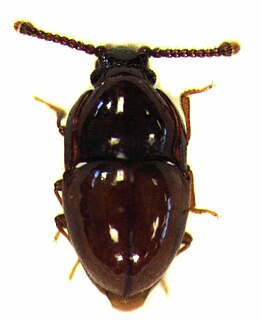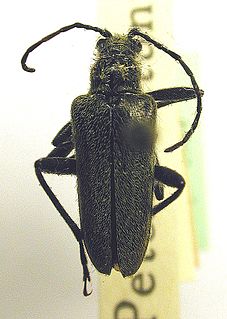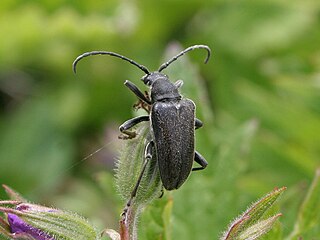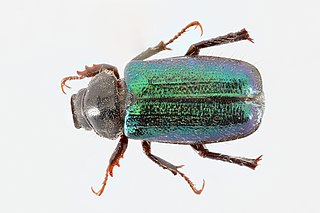
The insects of the beetle family Chrysomelidae are commonly known as leaf beetles, and include over 37,000 species in more than 2,500 genera, making up one of the largest and most commonly encountered of all beetle families. Numerous subfamilies are recognized, but the precise taxonomy and systematics are likely to change with ongoing research.

Dynastinae or rhinoceros beetles are a subfamily of the scarab beetle family (Scarabaeidae). Other common names – some for particular groups of rhinoceros beetles – include Hercules beetles, unicorn beetles or horn beetles. Over 1500 species and 225 genera of rhinoceros beetles are known.

Cryptophagidae is a family of beetles with representatives found in all biogeographic realms. Members of this family are commonly called silken fungus beetles and both adults and larvae appear to feed exclusively on fungi although in a wide variety of habitats and situations, such as rotting wood and shed animal fur and feathers. These beetles vary from about 1 to 11 millimeters long, and usually have an oval body shape with a slight "waist".

Sericoda is a genus of harpaline ground beetles. They are native to the Holarctic. Their habit resembles some members of the related genus Agonum, but they are generally smaller. The origin of Sericoda is apparently North America, with the Central American genus Elliptoleus the closest living relative.

The blister beetle genus Meloe is a large, widespread group commonly referred to as oil beetles. They are known as "oil beetles" because they release oily droplets of hemolymph from their joints when disturbed; this contains cantharidin, a poisonous chemical causing blistering of the skin and painful swelling. Members of this genus are typically flightless, without functional wings, and shortened elytra.

Nicrophorus vespilloides is a burying beetle described by Johann Friedrich Wilhelm Herbst in 1783.

Agabus is a large genus of predatory aquatic beetles in the family Dytiscidae, proposed in 1817 by William Elford Leach and named after Agabus, an early follower of Christianity. The adult beetles are moderate-sized, 5 to 14 mm long. The genus is primarily Holarctic in distribution, with only a few species known from the Afrotropical and Neotropical realms. Three species of Agabus, namely A. clypealis, A. discicollis and A. hozgargantae are endangered according to the IUCN Red List. The division into subgenera is not widely accepted. However, a number of species groups are recognized after the works of David J. Larson and Anders N. Nilsson. The genus is probably polyphyletic or paraphyletic. In a recent study of mitochondrial DNA, Agabus was found paraphyletic with respect to several of the species groups of Platambus, a closely related genus in the tribe Agabini. Lately the taxonomy of the genus has been revised, and some groups of species were transferred from Agabussensu stricto to other genera in the tribe Agabini.

Silvanidae, "silvan flat bark beetles", is a family of beetles in the superfamily Cucujoidea, consisting of 58 described genera and about 500 described species. The family is represented on all continents except Antarctica, and is most diverse at both the generic and species levels in the Old World tropics.

Acmaeops smaragdula is a species of the Lepturinae subfamily in the long-horned beetle family. This beetle is distributed in Belarus, Finland, France, China, Italy, Latvia, Mongolia, Norway, Poland, Russia, Sweden, and Switzerland.

Acmaeops septentrionis is a species of the Lepturinae subfamily in the long-horned beetle family. This beetle is distributed in Austria, Belarus, Bulgaria, Czech Republic, Estonia, Finland, France, Germany, China, Italy, Japan, Latvia, Lithuania, Mongolia, North Korea, Norway, Poland, South Korea, Romania, Russia, Slovakia, Slovenia, Sweden, Switzerland, and Ukraine. Adult beetle feeds on Norway spruce.

Acmaeops marginata is a species of the Lepturinae subfamily in the longhorn beetle family. It was described by Johan Christian Fabricius in 1781 and is known from Austria, Belarus, Belgium, Baltic states, Bosnia and Herzegovina, Croatia, Czech Republic, Finland, France, Germany, Greece, Italy, Norway, Poland, Russia, Serbia, Slovakia, Spain, Sweden, Switzerland, Ukraine, China, Mongolia, and Montenegro. Adult beetle feeds on Scots pine, and Norway spruce.
Acmaeops brachyptera is the species of the Lepturinae subfamily in long-horned beetle family. This beetle is distributed in China, and Kazakhstan.

Acmaeops pratensis is a species of the Lepturinae subfamily in the long-horned beetle family. This beetle is distributed in Austria, Belarus, Bosnia and Herzegovina, Bulgaria, Canada, Croatia, Czech Republic, Estonia, Finland, France, Germany, Hungary, China, Italy, Kazakhstan, Latvia, Lithuania, Moldova, Mongolia, Montenegro, North Macedonia, Norway, Poland, Romania, Russia, Serbia, Slovakia, Slovenia, Spain, Sweden, Switzerland, Ukraine, and the United States. The adult beetle feeds on Norway spruce.

Dinoptera collaris is the species of the Lepturinae subfamily in long-horned beetle family.

Dicerca is a genus of beetles in the family Buprestidae, containing the following species:
Agonum affine is a species of ground beetle in the Platyninae subfamily. It was described by William Forsell Kirby in 1837 and is endemic to the United States.

Acmaeops is a genus of beetles in the family Cerambycidae, containing the following species:
Acmaeops discoideus is a long-horned beetle in the flower longhorn subfamily, Lepturinae. It is found in the United States and Canada, and feeds on Virginia pine.

The milkweed leaf beetle is a species of beetle from the family Chrysomelidae.

Dichelonyx is a genus of May beetles and junebugs in the family Scarabaeidae. There are at least 30 described species in Dichelonyx.

















